Dreaming of a Master’s in Information Technology? Well, the USA is hands down the top destination and for good reason. It’s home to over 50% of the world’s unicorn startups, tech giants like Google, Amazon, Apple, and Meta, and universities that consistently rank in the Top 10 globally for Computer Science.
Pursuing a Masters in Information Technology in USA is a top choice for international students seeking cutting-edge education, industry exposure, and global career opportunities.
With 682,800+ new IT jobs projected by 2031 (U.S. Bureau of Labor Statistics) and 36 months of post-study work rights through the STEM OPT extension, studying IT in the USA is not just a degree, it’s a direct pathway to a global career.
Benefits of Studying Masters in Information Technology in USA
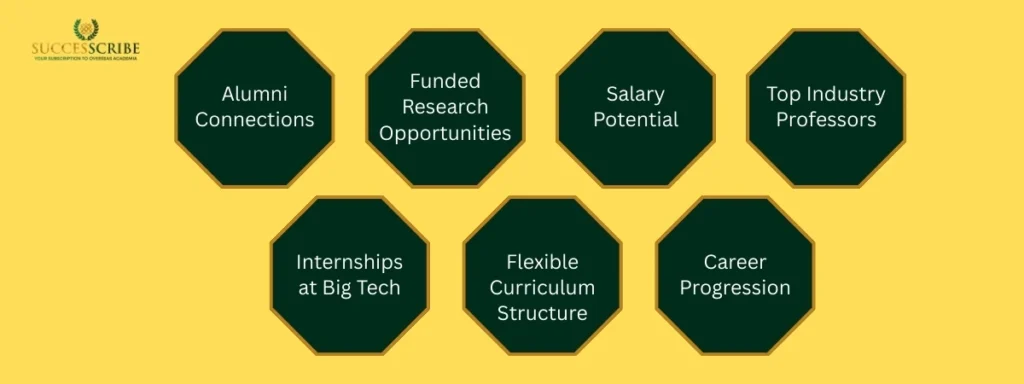
Here are the benefits of studying Master’s in IT in USA
| Feature | Description/Advantage |
| Alumni Connections | 240,000+ alumni from Stanford alone |
| Funded Research Opportunities | NSF funds $8B+ in STEM research annually |
| Salary Potential | Avg. $95K+ starting salary for MSIT grads |
| Top Industry Professors | Learn from CTOs, entrepreneurs, and real-world experts |
| Internships at Big Tech | Built-in co-op programs with Amazon, IBM, Intel, etc. |
| Flexible Curriculum Structure | Combine IT with business, health, or design |
| Career Progression | Smooth H-1B to Green Card transition |
Suggested Post: Masters in data science in USA
Top Universities for IT Master’s Program
While rankings fluctuate annually, certain universities consistently excel in IT graduate education:
Traditional Leaders
- Massachusetts Institute of Technology (MIT)
- Stanford University
- Carnegie Mellon University
- University of California, Berkeley
- University of Washington
- Georgia Institute of Technology
- University of Illinois at Urbana-Champaign
- University of Michigan
- Cornell University
- Princeton University
- John Hopkins University
Rising Programs
- Northeastern University (particularly for cooperative education model)
- Arizona State University (online program innovations)
- University of Texas at Dallas (industry connections)
- North Carolina State University (value and outcomes)
- University of Minnesota (data science focus)
- Virginia Tech (cybersecurity excellence)
- University of California -San Diego (AI specialization)
- Purdue University (information security leadership)
- Texas A&M University (data engineering focus)
- University of Wisconsin—Madison (emerging tech curriculum)
Program Selection Factors
When evaluating programs, consider these key differentiators:
- Faculty expertise: Research output and industry experience in your area of interest
- Curriculum flexibility: Ability to customize your course selection
- Industry connections: Recruitment relationships and alumni network strength
- Research opportunities: Access to labs and funded projects
- Career outcomes: Employment rates, starting salaries, and employer diversity
- Location advantages: Proximity to industry hubs relevant to your career goals
Top 10 Universities for Masters in Information Technology
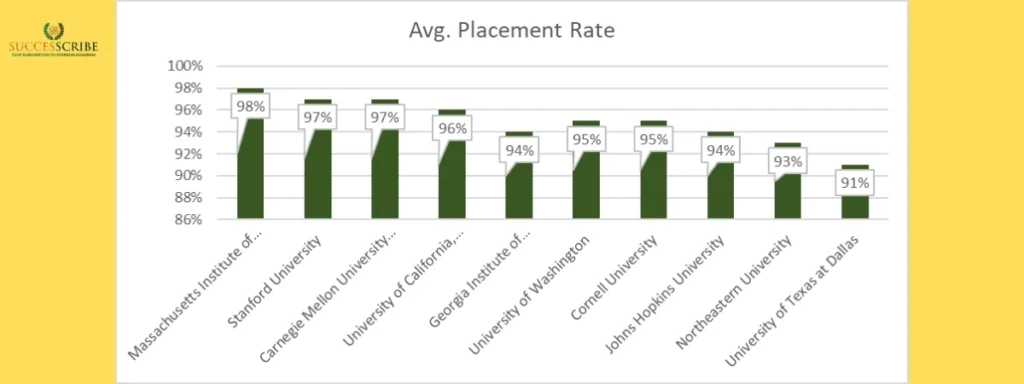
When selecting your ideal Masters in Information Technology in USA program, weigh not just rankings but how the university aligns with your specialization and career vision.
| University Name | Key Specializations | Avg. Placement Rate | Avg. Starting Salary |
| Massachusetts Institute of Technology (MIT) | Artificial Intelligence, Data Science, Cybersecurity | 98% | $125,000+ |
| Stanford University | Cloud Computing, HCI, Software Engineering | 97% | $122,000+ |
| Carnegie Mellon University (CMU) | Cybersecurity, AI, Systems Design | 97% | $120,000+ |
| University of California, Berkeley | Data Analytics, Machine Learning, Software Systems | 96% | $118,000+ |
| Georgia Institute of Technology | IT Infrastructure, Security, Networking | 94% | $110,000+ |
| University of Washington | HCI, Data Engineering, Cloud Platforms | 95% | $112,000+ |
| Cornell University | Information Systems, Business Analytics | 95% | $114,000+ |
| Johns Hopkins University | Health IT, Security, Cloud-based Systems | 94% | $108,000+ |
| Northeastern University | Cybersecurity, IT Management, DevOps | 93% | $100,000+ |
| University of Texas at Dallas | Enterprise Systems, Data Management, IT Strategy | 91% | $95,000+ |
Suggested Post: Masters in cyber security in USA
What you’ll Study: Masters in Information Technology USA Curriculum
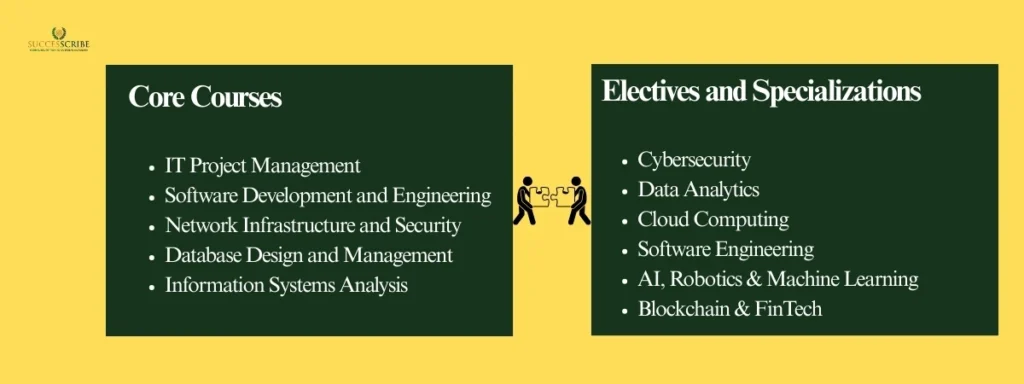
MS in IT programs in the U.S. balance practical application with theoretical learning. Programs typically last 1.5 to 2 years and consist of:
Core Courses
- IT Project Management
- Software Development and Engineering
- Network Infrastructure and Security
- Database Design and Management
- Information Systems Analysis
Electives and Specializations
Many programs offer niche areas such as:
| Specialization | Description |
| Cybersecurity | Threat modeling, encryption, and system security |
| Data Analytics | Big data, machine learning, data visualization |
| Cloud Computing | AWS, Azure, distributed computing |
| Software Engineering | Teaches Agile, DevOps, full-stack development |
| AI, Robotics & Machine Learning | Neural networks, deep learning & Computer Vision |
| Blockchain & FinTech | Distributed ledger tech, smart contracts |
Capstone or Research Thesis
In the final semester, students usually work on:
- A capstone project (industry or research-based)
- A research thesis (especially in research-heavy institutions)
Suggested Post: Masters in computer science in USA
Admission Requirements for Master’s in Information Technology in the USA
Gaining admission to a U.S. university for a Master’s in Information Technology involves meeting several academic and application-related criteria. While exact requirements vary by university, most institutions follow a standard framework. Gaining admission to a Masters in Information Technology in USA involves more than grades it’s about showcasing your passion for solving real-world problems with tech.
Below is a detailed breakdown of the core admission requirements you need to fulfill:
| Requirement | Description |
| Undergraduate Degree | 4-year degree in IT, CS, or related field |
| GPA | Minimum 3.0 on 4.0 scale (or equivalent) |
| GRE | 310–325 (optional/required based on program) |
| IELTS/TOEFL | IELTS 6.5–7.5 / TOEFL 80–100 |
| SOP | 800–1200 words about goals and motivations |
| LORs | 2–3 from academic or work-related references |
| Resume/CV | Highlighting projects, skills, certifications |
| Work Experience | Optional but beneficial (1–3 years preferred) |
1. Bachelor’s Degree in a Related Field
You must hold a 4-year undergraduate degree in a relevant field such as:
- Information Technology
- Computer Science
- Software Engineering
- Electronics or Electrical Engineering
- Data Science
- Mathematics or related disciplines
Most top universities expect a minimum GPA of 3.0 on a 4.0 scale (roughly 65–70% or more in Indian universities).
Some programs may admit students from non-tech backgrounds if they complete prerequisite courses or have relevant work experience.
2. GRE Scores (Optional/Recommended)
- GRE (Graduate Record Examination) is accepted or recommended by many universities.
- Top-tier universities like MIT, Stanford, or CMU may require strong GRE scores (typically 310–325+).
- However, many universities have made the GRE optional post-pandemic.
Always check the program-specific requirement — if it’s optional, submitting a strong score can still boost your chances.
3. English Language Proficiency (IELTS/TOEFL)
If English isn’t your native language (as is the case for Indian students), you must provide English test scores:
| Test | Minimum Score Required |
| IELTS | 6.5–7.5 |
| TOEFL iBT | 80–100 |
| Duolingo | 105–120 (accepted by some universities) |
Highly competitive universities may require IELTS 7+ or TOEFL 100+
4. Academic Transcripts
- You must submit official transcripts from all undergraduate (and postgraduate, if applicable) institutions attended.
- Some universities may ask for WES (World Education Services) evaluation to convert marks into U.S. GPA format.
5. Statement of Purpose (SOP)
A well-written SOP (800–1200 words) is crucial. It should explain:
- Why you want to study IT
- Why you’ve chosen this particular university
- Your career goals
- Your academic and technical background
A strong SOP can make or break your application, especially if you’re applying to top programs.
6. Letters of Recommendation (LORs)
Typically, 2 to 3 letters are required.
These should come from:
- Professors who taught you
- Research advisors
- Workplace supervisors (if you have work experience)
LORs should reflect your academic performance, research potential, and technical abilities.
7. Resume/CV
Your academic CV should include:
- Educational background
- Relevant projects
- Programming languages & tools you know
- Internships or job experience
- Certifications (like AWS, Cisco, etc.)
8. Work Experience (Optional but Valued)
Work experience is not mandatory for most MSIT programs, but having 1–3 years of industry experience in IT or software development can significantly strengthen your profile.
Suggested Post: Masters in cloud computing in USA
Student Visa Process for International Students
International students pursuing IT Master’s degrees typically require an F-1 student visa:
Application Requirements
- Form I-20 (issued by the university after admission)
- Proof of financial resources covering first-year expenses
- Visa application fee ($160) and SEVIS fee ($350)
- Valid passport
- Evidence of ties to home country and intent to return after studies
According to US Department of State data, F-1 visa approval rates for STEM students have ranged from 80-92% in recent years, varying significantly by country of origin. Students from China and India face more stringent scrutiny, with approval rates averaging 76% and 82% respectively.
Work While Studying Masters in Information Technology in USA
- On-campus jobs (up to 20 hours/week)
- Optional Curricular Practical Training (CPT) during breaks
OPT & STEM Extension
- OPT: Work up to 12 months post-graduation
- STEM OPT Extension: Extra 24 months for IT/CS grads
- Total: 36 months of work opportunity post-study
Suggested Post: Masters in computer science in USA
Cost of Studying Masters in Information Technology in USA
Understanding the financial commitment is crucial for prospective students. Here’s a breakdown of the estimated costs:
Tuition Fees
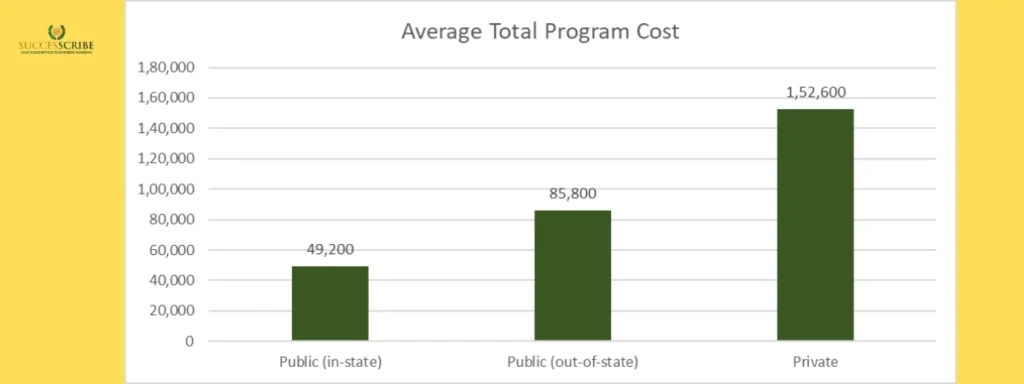
Tuition costs for IT Master’s programs vary significantly based on several factors
| Institution Type | Annual Tuition Range | Average Total Program Cost |
| Public (in-state) | $12,800 – $24,600 | $25,600 – $49,200 |
| Public (out-of-state) | $27,500 – $42,900 | $55,000 – $85,800 |
| Private | $35,800 – $76,300 | $71,600 – $152,600 |
Living Expenses
Regional cost-of-living differences create substantial variations in total budget needs:
| City/Region | Monthly Rent | Monthly Living Expenses | Annual Total (excluding tuition) |
| San Francisco | $2,850 | $1,900 | $57,000 |
| Boston | $2,400 | $1,750 | $49,800 |
| New York | $2,700 | $1,950 | $55,800 |
| Seattle | $1,950 | $1,700 | $43,800 |
| Austin | $1,450 | $1,550 | $36,000 |
| Pittsburgh | $1,250 | $1,400 | $31,800 |
| Raleigh | $1,350 | $1,350 | $32,400 |
Suggested Post: Masters in artificial intelligence in USA
Job Market and Career Opportunities After MS in Information Technology in the USA
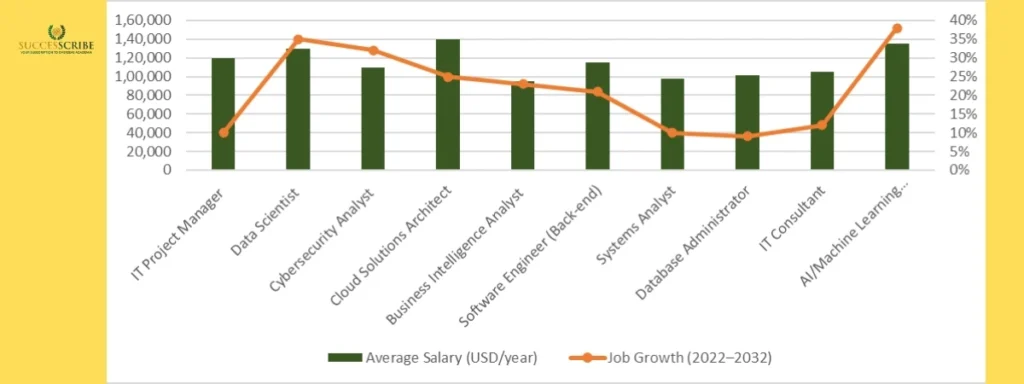
A Masters in Information Technology in USA equips you with both the technical expertise and work authorization needed to thrive in one of the world’s most dynamic IT job markets. According to the U.S. Bureau of Labor Statistics (BLS), employment in computer and information technology occupations is projected to grow 15% from 2022 to 2032, much faster than the average for all occupations. This growth is expected to add more than 682,800 new jobs in the next decade.
Top Career Roles After Masters in IT
| Job Role | Average Salary (USD/year) | Job Growth (2022–2032) |
| IT Project Manager | $120,000+ | 10% |
| Data Scientist | $130,000+ | 35% |
| Cybersecurity Analyst | $110,000+ | 32% |
| Cloud Solutions Architect | $140,000+ | 25% |
| Business Intelligence Analyst | $95,000+ | 23% |
| Software Engineer (Back-end) | $115,000+ | 21% |
| Systems Analyst | $98,000+ | 10% |
| Database Administrator | $101,000 | 9% |
| IT Consultant | $105,000+ | 12% |
| AI/Machine Learning Engineer | $135,000+ | 38% |
Suggested Post: Duolingo accepting universities in USA
Scholarships for Indian Students Pursuing MS in Information Technology in the USA
Pursuing a Masters in Information Technology in USA is a significant investment, with average costs ranging between ₹30–55 lakhs. However, Indian students have access to several prestigious government and private scholarships that can reduce tuition burden and living expenses.
| Scholarship Name | Provider | Scholarship Amount / Coverage |
| Fulbright-Nehru Master’s Fellowship | USIEF | Full tuition, living, airfare, insurance |
| J.N. Tata Endowment Scholarship | Tata Trusts | ₹1 to ₹10 lakhs (loan scholarship) |
| Inlaks Shivdasani Foundation Scholarship | Inlaks Foundation | Up to $100,000 |
| Narotam Sekhsaria Scholarship | Narotam Sekhsaria Foundation | Up to ₹20 lakhs (interest-free loan) |
| KC Mahindra Scholarship for PG Studies Abroad | KC Mahindra Education Trust | Up to ₹8 lakhs (interest-free loan) |
| Tata Scholarship (Cornell University only) | Tata Education and Development Trust | Full tuition and expenses |
Tips to Win a Scholarship:
- Apply early – Deadlines are often 6–12 months before the course starts.
- Tailor your Statement of Purpose to align with each foundation’s mission.
- Secure strong Letters of Recommendation from professors or employers.
- Include any tech certifications or published research to show your IT potential.
Suggested Post: Best US States for International Students
Why Choose the USA for a Master’s in Information Technology?
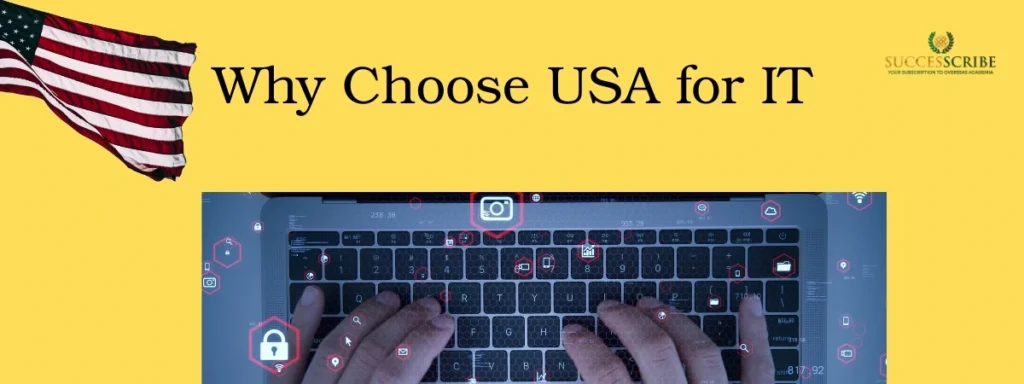
Choosing the USA for your Master’s in Information Technology isn’t just a trend — it’s a smart, data-backed decision. Choosing a Masters in Information Technology in USA means immersing yourself in an ecosystem where research labs, tech startups, and industry giants exist side-by-side. Here’s why thousands of international students, especially from India, make the move every year:
1. Massive IT Job Openings
The U.S. Bureau of Labor Statistics reports that the number of IT jobs is expected to grow by 15% between 2021 and 2031, which is much faster than the average across other sectors. That’s nearly 682,800 new IT jobs over the decade in areas like cloud computing, cybersecurity, software development, and data analytics.
2. Birthplace of the World’s Biggest Tech Startups
The USA is the birthplace of over 50% of the world’s unicorn startups including giants like:
- Google (Alphabet) – started at Stanford
- Facebook (Meta) – born at Harvard
- Amazon – launched from a Seattle garage
- Microsoft – built in New Mexico
- Apple – started in a California garage
Today, the USA hosts over 320 unicorns, more than any other country in the world.
3. Home to Top-Ranked Universities in IT & CS
Out of the top 10 global universities for Computer Science & Information Systems, 6 are American:
| Rank | University |
| 1 | Massachusetts Institute of Technology (MIT) |
| 2 | Stanford University |
| 3 | Carnegie Mellon University |
| 4 | University of California, Berkeley |
| 6 | Harvard University |
| 10 | University of Washington |
These universities are research powerhouses with state-of-the-art labs, industry ties, and AI/ML innovation centers.
4. Industry-Aligned and Future-Proof Curriculum
Unlike many countries, U.S. universities frequently update their IT curricula to match evolving tech trends. Programs include hands-on capstone projects, internships, and elective tracks in:
- Cybersecurity
- Data Science
- Cloud Computing
- Blockchain
- AI & Machine Learning
This ensures graduates are job-ready from day one.
5. STEM Advantage: Work for 3 Years After Graduation
IT programs in the USA fall under STEM-designated degrees, which allow international graduates to:
- Stay back for 12 months of OPT
- Extend it by 24 more months via STEM OPT Extension
- Total: 36 months (3 years) of work experience before needing employer visa sponsorship
6. Largest Tech Economy in the World
- The U.S. tech industry is worth $2 trillion, contributing over 8.9% of the GDP
- It employs more than 12 million tech workers
- Cities like San Francisco, Seattle, Boston, Austin, and NYC are booming with tech hiring and startup capital.
7. Research Funding and Innovation Ecosystem
U.S. universities receive billions in research funding from government and private sources:
- In 2022, MIT received over $1.1 billion in research grants.
- The National Science Foundation (NSF) spends $8 billion+ annually, much of it on tech-related research.
- You can work on live projects in AI, robotics, cloud, quantum computing, or IoT, often funded by NASA, DARPA, or Google AI.
8. Learn from Top Minds in the Industry
Many professors in top U.S. universities are industry leaders, consultants to Fortune 500 companies, or former CTOs. Learning directly from such experts brings:
- Practical, up-to-date insight
- Access to internships and research collaborations
- A mentorship advantage in navigating the U.S. job market
Conclusion
Pursuing a Masters in Information Technology in USA represents a significant investment of time, money, and effort. For many students, particularly those seeking specialized technical knowledge and access to the American technology sector, this investment yields substantial returns in career advancement, earning potential, and professional network development.
FAQs
Is GRE mandatory for MS in Information Technology in the USA?
GRE is optional for many universities post-pandemic. However, top-tier schools like MIT, Stanford, or CMU may still require or recommend it. A strong score (310–325+) can strengthen your application even if not required.
Can I pursue MSIT in the USA without a Computer Science background?
Yes, many universities accept students from related fields like Electronics, Mathematics, or even non-tech backgrounds if you’ve completed prerequisites or have relevant work experience.
What are the average total expenses for Indian students pursuing MSIT in the USA?
On average, the total cost (tuition + living) ranges from ₹30 to ₹55 lakhs, depending on the university and city. Scholarships and assistantships can significantly reduce this.
How much can I earn after completing MSIT in the USA?
Average starting salaries range between $95,000 to $125,000, depending on your specialization and location.
What is the job placement rate for top MSIT universities?
Leading universities like MIT, Stanford, and CMU report placement rates above 95%, with most students securing jobs within 3–6 months of graduation.
What’s the difference between MS in Information Technology and MS in Computer Science in the USA?
While MS in Computer Science is more theory and algorithm-heavy, MS in Information Technology focuses on practical IT systems, cybersecurity, data management, and enterprise tech. IT is better suited for managerial or business-tech hybrid roles.
Are there MSIT programs in the USA that don’t require coding knowledge?
Yes. Schools like Carnegie Mellon (ETIM), NYU (Management of Technology), or Northeastern (Information Systems) offer tracks with minimal programming, focusing more on IT strategy, systems analysis, and leadership.
Related Post
Masters in HR management in USA
Masters in health informatics in USA
Masters in health administration in USA
Masters in engineering management in USA















